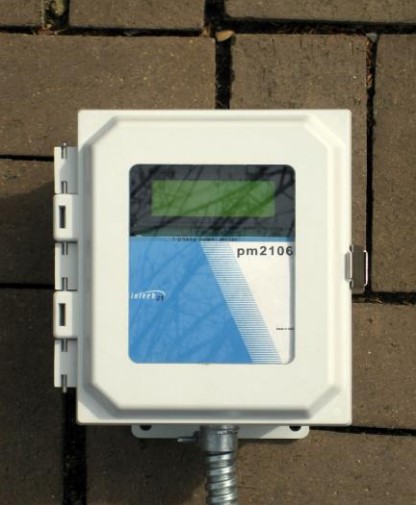Power Meter PM-2106is designed by Intech 21, Inc. for the purpose of accurate metering of the electrical power, voltage, consumed energy and demand in “Δ” or “Y” three-phase power distribution system. The PM2106 is a multifunctional device featuring configurable power quality and electrical energy meter with built-in wireless radio communication interface, wired communication interface with MODBUS protocol, LCD display and internal temperature sensor and add-on multipurpose I/O channels.
Embedded Radio Communication Device is configured as a Wireless Network Node, allowing the Power Meter to participate in the Intech21 Wireless Control Network.
The Wireless Control Network is designed to simplify deployment and reduce the cost of installation of the Building Monitoring and Control System, which standard operation is to perform a variety of Data Acquisition and Control functions, e.g. Power Meter reading, Smoke Detector monitoring, Temperature Sensor reading, Electrical Heating/Cooling control, and operating the Electrical Power Load Control devices for power savings etc. The system is WEB-enabled, with the purpose of easy user access via the Internet to the building's real-time data as well as to the information stored in the Central Database.
The Wireless Control Network is designed to simplify deployment and reduce cost of installation of the Building Monitoring and Control System, which standard operation is to perform a variety of Data Acquisition and Control functions, e.g. Power Meter reading, Smoke Detector monitoring, Temperature Sensor reading, Electrical Heating/Cooling control, and operating the Electrical Power Load Control devices for power savings etc. The system is WEB-enabled, with the purpose of easy user access via the Internet to the building's real-time data as well as to the information stored in the Central Database.
As the Wireless Network has self-configuring features with an intrinsic structural hierarchical organization, the network units do not require hardware preprogramming prior to or during installation and the units are easily interchangeable, which reduces the possibility of installation errors by personnel.
The Wireless Network operates in 902-928MHz frequency band dedicated for non-licensed Industrial Scientific Medical (ISM) applications in the USA. Versions for other frequency bands are also available.
The Power Meter’s LCD display shows measured real-time data and capable of displaying text messages provided by the System, e.g. billing information to the tenants. The LCD backlight can be turned on/off remotely to attract attention to a new message.

Specifications
Power Meter Type: Four Wire Three-Element Transformer rated Solid-State Meter
Baseline Standards: ANSI C12.1, ANSI C12.16, UL3111-1, CSA22.2 NO. 1010-1
Voltage and Frequency Rating: 110 - 480V, 60 Hz
Voltage Input Configuration: Three-phase, 4-wire: Line A, Line B, Line C and Neutral
Voltage Input: 110-480 V RMS Connecting Wires: 14AWG to 12AWG
Current Input: External Current Transformers. Measured Parameters; Accumulated Energy; Voltage per phase in range 100 – 600V; Current per phase in programmable range; Active Power per phase; Reactive Power per phase; Apparent Power per phase; Power Factor per phase; Frequency; Temperature; Energy usage in a demand interval (may be 1 to 60 minutes); Current Demand calculated according one of five standard methods; Peak Demand since last reset; Peak Demand Time.
Display data representation: The LCD display on the front panel of the power meter has four 20-character strings.
Data Retention: Data flash memory on PM2106DM allows optional logging of measured data. Energy usage may be saved in a log for each demand interval and may be retrieved by the MODBUS.
Power Consumption: Not more than 4W
Display: LCD display 20x4 characters
Interface: RS485, MODBUS
Enclosure: type NEMA 4X, PJU86LWF size 9.6 x 7.5x 5.2
Environmental Conditions: Indoor and outdoor use. Placement: Enclosed Power Distribution Panel. Temperature Range: -20°C to +50°C. Note: Limited by LCD temperature range. Altitude up to 2000m. Maximum relative humidity 80% for temperatures up to 31°C decreasing linearly to 50% relative humidity at 40°C. POLLUTION DEGREE 2 in accordance with IEC664.